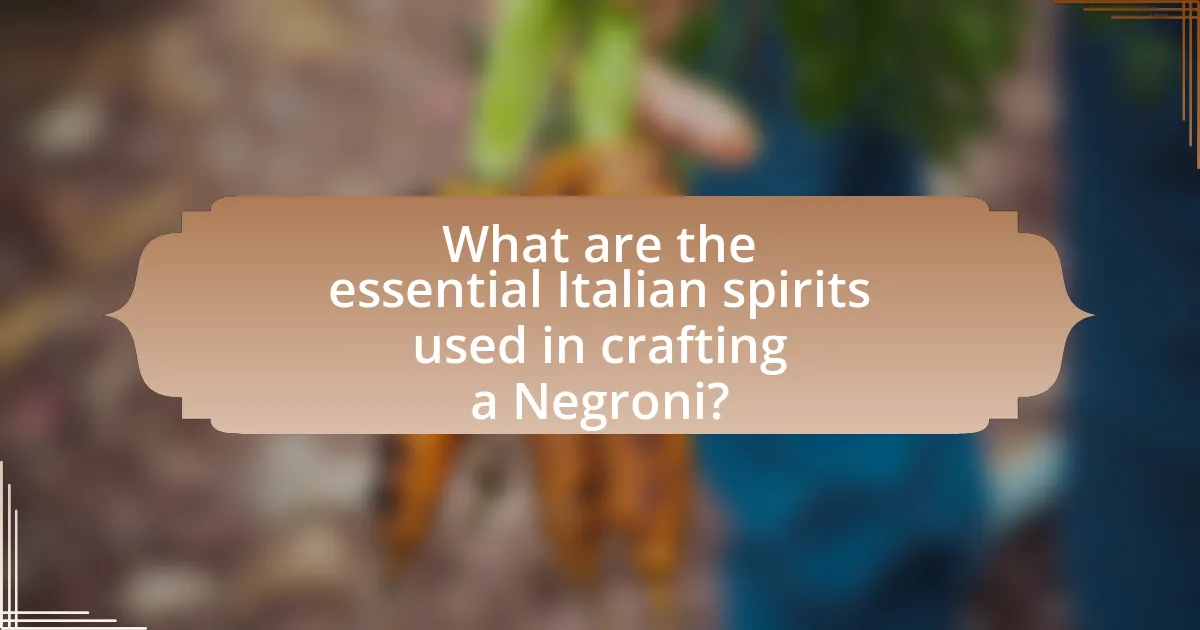The article focuses on crafting the perfect Negroni, a classic Italian cocktail made from equal parts gin, Campari, and sweet vermouth. It explores the significance of the Negroni in Italian culture, its traditional preparation methods, and the importance of ingredient ratios for achieving a balanced flavor profile. Additionally, the article discusses the roles of key ingredients, including gin, Campari, and sweet vermouth, and highlights popular variations and customization options. Techniques for enhancing the Negroni experience, common mistakes to avoid, and recommendations for high-quality ingredients are also covered, providing a comprehensive guide for both novice and experienced cocktail enthusiasts.

What is a Negroni and its significance in Italian culture?
A Negroni is a classic Italian cocktail made from equal parts gin, Campari, and sweet vermouth, typically garnished with an orange peel. Its significance in Italian culture lies in its representation of the aperitivo tradition, which emphasizes socializing and enjoying drinks before dinner. The Negroni originated in Florence in the early 20th century, attributed to Count Camillo Negroni, who requested a stronger version of the Americano cocktail. This drink has become a symbol of Italian craftsmanship and culinary heritage, celebrated for its balance of bitter and sweet flavors, reflecting the Italian appreciation for quality ingredients and sophisticated taste.
How is a Negroni traditionally prepared?
A Negroni is traditionally prepared by combining equal parts of gin, sweet vermouth, and Campari. The preparation involves pouring these ingredients into a mixing glass filled with ice, stirring until well chilled, and then straining the mixture into a rocks glass filled with ice. Finally, a twist of orange peel is added as a garnish. This classic cocktail originated in Florence, Italy, in the early 20th century, attributed to Count Camillo Negroni, who requested a stronger version of the Americano cocktail.
What are the key ingredients in a classic Negroni?
The key ingredients in a classic Negroni are equal parts of gin, Campari, and sweet vermouth. This cocktail, originating from Italy, combines the herbal and bitter notes of Campari with the botanical flavors of gin and the sweetness of vermouth, creating a balanced and complex drink. The Negroni is traditionally garnished with an orange twist, enhancing its aromatic profile.
What is the importance of the ratios in a Negroni recipe?
The ratios in a Negroni recipe are crucial for achieving a balanced flavor profile. The classic Negroni consists of equal parts gin, Campari, and sweet vermouth, which ensures that no single ingredient overpowers the others, creating a harmonious blend of bitterness, sweetness, and herbal notes. This balance is essential because it allows the distinct characteristics of each spirit to shine through while maintaining overall drinkability. Additionally, precise ratios help in replicating the cocktail consistently, which is vital for both home bartenders and professionals aiming to deliver the same quality in every serving.
Why is the Negroni considered a timeless cocktail?
The Negroni is considered a timeless cocktail due to its perfect balance of flavors and its enduring popularity since its creation in the early 20th century. This cocktail, made with equal parts gin, Campari, and sweet vermouth, offers a harmonious blend of bitterness, sweetness, and herbal notes, appealing to a wide range of palates. Its origins trace back to Florence, Italy, around 1919, when Count Camillo Negroni requested a stronger version of the Americano, leading to its unique formulation. The Negroni’s simplicity in ingredients and preparation, combined with its rich history and cultural significance, solidifies its status as a classic in cocktail culture.
What historical events contributed to the Negroni’s popularity?
The Negroni gained popularity due to several historical events, notably its creation in the early 20th century in Florence, Italy, when Count Camillo Negroni requested a stronger version of the Americano cocktail. This request led to the addition of gin, which transformed the drink and marked its inception around 1919. The cocktail’s association with Italian culture and its subsequent spread through bars in Italy and abroad during the mid-20th century, particularly post-World War II, further solidified its status. Additionally, the cocktail renaissance of the 2000s, which emphasized classic cocktails, played a significant role in reviving interest in the Negroni, making it a staple in modern cocktail culture.
How has the Negroni evolved over the years?
The Negroni has evolved from a simple Italian aperitif into a globally recognized cocktail with numerous variations. Originally created in Florence in the early 20th century, the drink combined equal parts gin, vermouth, and Campari, reflecting the Italian tradition of bitter-sweet cocktails. Over the years, bartenders have experimented with different spirits, such as replacing gin with whiskey or mezcal, leading to variations like the Boulevardier and the Mezcal Negroni. Additionally, the rise of craft cocktail culture has introduced innovative ingredients and techniques, such as barrel-aging and the use of artisanal bitters, further diversifying the Negroni’s profile. This evolution highlights the cocktail’s adaptability and enduring popularity in contemporary mixology.

What are the essential Italian spirits used in crafting a Negroni?
The essential Italian spirits used in crafting a Negroni are gin, Campari, and sweet vermouth. Gin provides the base spirit, contributing botanical flavors; Campari adds a bitter and aromatic profile; and sweet vermouth introduces sweetness and complexity. This combination creates the classic Negroni, a cocktail that originated in Florence, Italy, in the early 20th century, showcasing the balance of bitter, sweet, and herbal notes that define this iconic drink.
What role does gin play in a Negroni?
Gin serves as the primary spirit in a Negroni, providing the cocktail with its distinctive botanical flavors. The choice of gin influences the overall taste profile, as different gins contain varying combinations of herbs and spices. Traditionally, a Negroni is made with equal parts gin, Campari, and sweet vermouth, creating a balanced drink where the gin’s crispness complements the bitterness of Campari and the sweetness of vermouth. This balance is essential for achieving the classic Negroni experience, which has been popular since its creation in the early 20th century.
How do different types of gin affect the flavor profile of a Negroni?
Different types of gin significantly influence the flavor profile of a Negroni. For instance, London Dry gin, known for its juniper-forward taste, imparts a crisp and aromatic quality, enhancing the herbal notes of the Campari and the sweetness of vermouth. Conversely, a more floral gin, such as a New Western or contemporary style, introduces softer, botanical flavors that can create a more nuanced and complex Negroni, balancing the bitterness of Campari with delicate floral and citrus notes. Additionally, Old Tom gin, which is slightly sweeter, can add a rich, rounded sweetness that complements the bitterness and enhances the overall depth of the cocktail. Each gin type alters the Negroni’s character, showcasing the versatility of this classic drink.
What are some recommended gin brands for making a Negroni?
Recommended gin brands for making a Negroni include Tanqueray, Bombay Sapphire, and Beefeater. Tanqueray is known for its balanced flavor profile, which complements the bitterness of Campari and the sweetness of vermouth. Bombay Sapphire offers a more floral and aromatic experience, enhancing the cocktail’s complexity. Beefeater, with its classic London Dry style, provides a robust juniper flavor that pairs well with the other ingredients. These brands are widely recognized for their quality and are often suggested by bartenders for crafting an authentic Negroni.
What is the significance of Campari in a Negroni?
Campari is significant in a Negroni because it provides the essential bitter flavor that balances the cocktail’s sweetness and enhances its complexity. This Italian aperitif, characterized by its vibrant red color and herbal notes, is one of the three primary ingredients in a Negroni, alongside gin and sweet vermouth. The bitterness of Campari not only complements the botanicals in gin but also contrasts with the sweetness of vermouth, creating a harmonious blend that is both refreshing and sophisticated. The historical context of Campari, originating in the 1860s, further solidifies its role as a classic component in this iconic cocktail, making it integral to the Negroni’s identity.
How does Campari contribute to the bitterness of a Negroni?
Campari contributes to the bitterness of a Negroni through its unique blend of bitter herbs, spices, and fruit extracts. This Italian aperitif is known for its distinct bitter flavor profile, which is primarily derived from its secret recipe that includes ingredients like gentian root and cinchona bark, both recognized for their bitter qualities. The bitterness from Campari balances the sweetness of vermouth and the strength of gin in a Negroni, creating a harmonious cocktail that is both complex and refreshing.
What are the flavor notes of Campari that enhance the cocktail?
Campari features prominent flavor notes of bitter orange, herbs, and spices that enhance cocktails, particularly the Negroni. The bitter orange provides a citrusy brightness, while the herbal and spicy undertones contribute complexity and depth, balancing the sweetness of vermouth and the strength of gin. This unique combination of flavors is essential in creating a well-rounded and sophisticated cocktail experience.
What is the role of sweet vermouth in a Negroni?
Sweet vermouth serves as a key ingredient in a Negroni, contributing sweetness and complexity to the cocktail. It balances the bitterness of Campari and the strength of gin, creating a harmonious flavor profile. The use of sweet vermouth, which is fortified and flavored with various botanicals, enhances the overall taste experience, making the Negroni a well-rounded drink. This role is essential, as the combination of these three ingredients—gin, Campari, and sweet vermouth—creates the classic Negroni, which has been a staple in cocktail culture since its creation in the early 20th century.
How does sweet vermouth balance the flavors in a Negroni?
Sweet vermouth balances the flavors in a Negroni by providing a rich, herbal sweetness that counteracts the bitterness of Campari and the strength of gin. This sweetness enhances the overall complexity of the cocktail, creating a harmonious blend of flavors. The botanicals in sweet vermouth, such as wormwood and various herbs, add depth and nuance, making the drink more rounded and enjoyable. The balance achieved by sweet vermouth is essential, as it transforms the Negroni from a one-dimensional bitter drink into a well-rounded cocktail that appeals to a wider range of palates.
What are some popular sweet vermouth options for a Negroni?
Some popular sweet vermouth options for a Negroni include Carpano Antica Formula, Dolin Rouge, and Martini & Rossi Rosso. Carpano Antica Formula is known for its rich flavor profile with notes of vanilla and spices, making it a favorite among cocktail enthusiasts. Dolin Rouge offers a lighter, more herbal taste, which balances well with the bitterness of Campari. Martini & Rossi Rosso is a classic choice that provides a sweet and slightly bitter flavor, complementing the gin in a Negroni effectively. These options are widely recognized for their quality and compatibility with the Negroni cocktail.

How can one customize a Negroni for personal taste?
To customize a Negroni for personal taste, one can adjust the proportions of gin, vermouth, and Campari, or substitute different spirits. For example, using a sweeter vermouth or a flavored gin can alter the drink’s profile significantly. Additionally, experimenting with different bitters or adding a splash of soda can create a lighter version. These modifications allow for a tailored experience, catering to individual preferences for sweetness, bitterness, and overall flavor balance.
What are some popular variations of the classic Negroni?
Some popular variations of the classic Negroni include the Negroni Sbagliato, which substitutes prosecco for gin, and the Boulevardier, which replaces gin with bourbon. The White Negroni uses Lillet Blanc and Suze instead of traditional ingredients, while the Mezcal Negroni incorporates mezcal for a smoky flavor. Each variation maintains the core elements of the original Negroni while introducing unique flavors, showcasing the versatility of this classic cocktail.
How does a Negroni Sbagliato differ from the traditional recipe?
A Negroni Sbagliato differs from the traditional Negroni recipe primarily by substituting prosecco for gin. In the traditional Negroni, the ingredients consist of equal parts gin, sweet vermouth, and Campari, creating a strong and bitter cocktail. The Negroni Sbagliato, however, replaces the gin with prosecco, resulting in a lighter, sparkling drink that maintains the bitter notes from the Campari and the sweetness from the vermouth. This variation originated in Italy and is often enjoyed as a refreshing alternative to the classic cocktail.
What unique ingredients can be added to create a signature Negroni?
Unique ingredients that can be added to create a signature Negroni include flavored bitters, herbal liqueurs, and infused spirits. For instance, using orange or chocolate bitters can enhance the complexity of the drink, while substituting traditional gin with a botanical gin or a barrel-aged gin introduces new flavor profiles. Additionally, incorporating herbal liqueurs like Aperol or Cynar can provide a unique twist, as these ingredients offer different sweetness and bitterness levels compared to classic Campari. These variations allow for a personalized Negroni experience while maintaining the cocktail’s foundational balance of bitter, sweet, and aromatic elements.
What techniques can enhance the Negroni experience?
To enhance the Negroni experience, techniques such as using high-quality ingredients, precise measurements, and proper chilling methods are essential. High-quality gin, vermouth, and Campari significantly impact the flavor profile, as premium spirits often have more complex and refined tastes. Precise measurements, typically equal parts of each ingredient, ensure a balanced cocktail, which is crucial for achieving the classic Negroni taste. Additionally, chilling the glass and ingredients before mixing prevents dilution and maintains the drink’s integrity, enhancing the overall drinking experience. These techniques are supported by the cocktail’s historical significance, as the Negroni has been a staple in Italian culture since its creation in the early 20th century, emphasizing the importance of quality and technique in crafting this iconic drink.
How does the choice of glassware impact the presentation of a Negroni?
The choice of glassware significantly impacts the presentation of a Negroni by influencing its visual appeal and the overall drinking experience. Using a short, wide glass, such as an Old Fashioned or rocks glass, enhances the drink’s vibrant colors and allows for easy garnishing with an orange twist, which is visually striking. In contrast, a coupe glass may elevate the drink’s sophistication but can obscure the visual elements that characterize a Negroni. The glass shape also affects the aroma, as a wider opening allows for better scent dispersion, enhancing the olfactory experience. Therefore, the selection of glassware not only affects aesthetics but also the sensory enjoyment of the cocktail.
What garnishes work best with a Negroni and why?
The best garnishes for a Negroni are an orange twist and a lemon twist. The orange twist enhances the drink’s citrus notes, complementing the bitterness of the Campari and the sweetness of the vermouth, while the lemon twist adds a bright acidity that balances the overall flavor profile. Both garnishes release essential oils that elevate the aromatic experience, making the cocktail more enjoyable.
What tips can help in perfecting the Negroni-making process?
To perfect the Negroni-making process, use equal parts of gin, Campari, and sweet vermouth for a balanced flavor. This ratio ensures that no single ingredient overpowers the others, creating a harmonious blend. Additionally, select high-quality ingredients, as the flavor of the Negroni heavily relies on the quality of the spirits used; for instance, using a premium gin can enhance the overall taste. Finally, serve the cocktail over a large ice cube to maintain the drink’s temperature without diluting it too quickly, which is crucial for preserving the intended flavor profile.
How can one achieve the ideal balance of flavors in a Negroni?
To achieve the ideal balance of flavors in a Negroni, one should use equal parts of gin, Campari, and sweet vermouth. This classic ratio ensures that the bitterness of Campari is balanced by the sweetness of vermouth and the botanical notes of gin, creating a harmonious blend. The traditional recipe, which originated in Italy, emphasizes this 1:1:1 ratio, allowing each ingredient to contribute equally to the overall flavor profile. Adjusting the proportions slightly can cater to personal taste preferences, but maintaining this foundational balance is key to a well-crafted Negroni.
What common mistakes should be avoided when crafting a Negroni?
Common mistakes to avoid when crafting a Negroni include using poor-quality ingredients, not balancing the proportions correctly, and neglecting proper chilling techniques. Using low-quality gin, vermouth, or Campari can significantly affect the drink’s flavor, as the Negroni relies on the quality of its components for a harmonious taste. The classic ratio of one part gin, one part vermouth, and one part Campari must be adhered to for optimal balance; deviating from this can lead to an unbalanced cocktail. Additionally, failing to chill the ingredients or the glass can result in a diluted and less enjoyable drink, as the Negroni is best served cold.










